Staff Editor’s Note
Experiencing Japan's Traditional Performing Art, Nohgaku
Partners’ Program at the Commemorative Summit for the 50th Year of ASEAN-Japan Friendship and Cooperation

Are you familiar with Nohgaku, a traditional Japanese performing art?
Nohgaku encompasses Noh, a form of lyrical drama, and Kyogen, which focuses on dialogue-centered comedy. Dating back centuries, this art form has been passed down through generations, especially nurtured under the patronage of samurai warriors, and remains vibrant and cherished to this day.

During the Partners’ Program at the Commemorative Summit for the 50th Year of ASEAN-Japan Friendship and Cooperation on December 18, 2023, the spouses of the Prime Minister of Japan and the leaders of various countries visited the National Noh Theatre to watch and experience Noh performances. Participating countries included Japan, the Republic of the Philippines, the Republic of Singapore, Malaysia, the Lao People's Democratic Republic, and the Kingdom of Cambodia, with Richard Emmert, emeritus professor of Musashino University serving as the guide.


National Noh Theatre
“Hagoromo (The Feather Robe)” Komparu School
The group's first experience was witnessing the climax of the Noh play called Hagoromo.
Hagoromo narrates the tale of a celestial maiden who returns to the celestial realm after a fisherman restores her hagoromo, or celestial shawl. When requested to dance in exchange for her hagoromo, the celestial maiden clarifies that she cannot perform without it. Doubting her sincerity, the fisherman wonders if she would still dance after receiving the hagoromo. However, the celestial maiden's assurance that such doubts only belong to earthly realm and that there is no deceit in the celestial realm grants him profound insight. Consequently, he willingly returns the hagoromo. This story offers insights into medieval Japanese religious beliefs.
Similar narratives are found not only in Asia but also across the globe, such as the Celtic Selkies or the Norse Valkyries. If you are acquainted with such tales, it could be intriguing to draw comparisons while watching the performance.

https://www.ntj.jac.go.jp/en/theatre/noh/
Nohgaku captivates audiences with its minimal use of set design and props, allowing imaginations to soar with every movement of the performers and every note of the music.
For instance, in Hagoromo, the stage is set amidst the picturesque landscape of Miho no Matsubara, a cultural treasure that contributes to the World Cultural Heritage site of Mount Fuji. Can you envision the crashing waves, the gentle rustle of pine trees, and the awe-inspiring sight of Mount Fuji?

National Diet Library Digital Collections
https://dl.ndl.go.jp/pid/11299484
Next, the group ventured into the dressing room to immerse themselves in the world of Noh, examining the intricate masks and costumes.
As they adorned themselves in the elaborate costumes and tried on the iconic Noh masks, the room filled with smiles and excitement.
There's a variety of Noh masks, but for Hagoromo, they used a refined female mask called Zo. The costumes, made of silk, are known for their lavish appearance. In the past, clothing worn by nobility were sometimes used during performances, and there was also a custom of receiving garments as rewards for performances, adding to the grandeur of Nohgaku.
In addition, Noh music involves vocal chants known as utai and instrumental accompaniments called hayashi. During their visit, the group had the opportunity to experiment with four instruments commonly used in hayashi: the fue (flute), kotsuzumi (shoulder drum), otsuzumi (hip drum), and taiko (stick drum). Under the guidance of experienced musicians, they joyfully explored the instruments and expressed delight as they produced melodious sounds.

The National Noh Theatre regularly opens its exhibition room to the public for free, so if you're interested in seeing Noh masks and costumes up close, be sure to visit.

Finally, discussions took place in an area overlooking the courtyard. On this day, the gentle sunlight streaming in through the windows seemed to brighten the lively discussions, almost as if it were illuminating the friendly relations between Japan and ASEAN countries.
During the discussion, the word “suruga” came up in conversation. In Malay, there is a similar word, “syurga,” which means paradise. The performance of Hagoromo, featuring the beautiful dance of a celestial maiden, is said to be the precursor to the Suruga Dance in Gagaku, which is a form of traditional Japanese performing art with a history of over a thousand years, originating from native Japanese song and dance as well as music and dance imported from abroad. While it may be a coincidence, it reflects the interconnectedness of Asian countries.

Related Information

National Noh Theatre
- Place
- 4-18-1 Sendagaya, Shibuya-ku, Tokyo 151-0051
At the National Noh Theatre, they also provide “National Noh Theatre Showcase,” which are condensed performances with workshops included, as well as "Discover NOH & KYOGEN" performances which come with English explanations.

